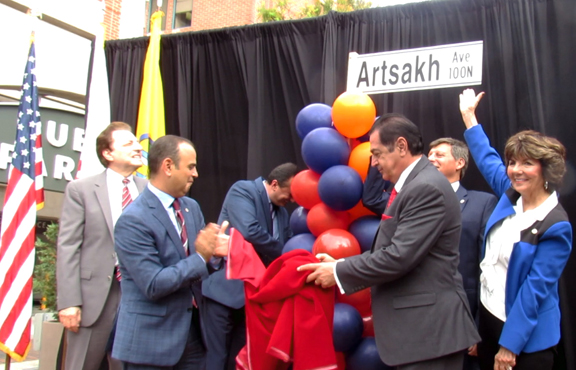
Glendale City Councilmember Paula Devine, with her fellow councilmembers, shows off the new sign proclaiming a portion of Maryland Avenue in Glendale being renamed Artsakh Avenue.
By Mary O’KEEFE
“Pride. That is the word,” said Arman Amirkhanyn, 17, a member of the Unified Young Armenians, as he and fellow members of UYA watched the renaming ceremony of Maryland Avenue to Artsakh Avenue in Glendale.
Officials spoke on Tuesday at the renaming event between Wilson and Harvard avenues. None of it would have been possible, though, if not for the initial UYA dream.
“It was in 2017, around the time of the [Armenian] Genocide [Remembrance Day], during the candlelight vigil,” Amirkhanyn said of how the idea began.
He said the group had talked about naming a street after Artsakh earlier in the year but it really became a conversation during the vigil.
The group sent a letter to the Glendale City Council on Feb. 2, 2018 asking it to consider changing the name of Sanchez Drive to Artsakh.
“We at first proposed Sanchez Drive because it looked like it was the easiest one to change,” Amirkhanyn said.
Changing the name of a street costs money for anyone on that street. Sanchez Drive seemed easier because there were no businesses that would be affected; however, members of the Hispanic community voiced their concerns.
“Sanchez was one of the first Mexican-American founders of Glendale,” said Glendale Councilmember Ara Najarian.
The City officials then looked at other streets and settled on the Arts and Entertainment portion of Maryland Avenue.
“This was a little of a rocky ride,” Najarian said.
There were some in the community who did not want the street changed. According to the City, there were 15 comments representing 32 addresses on the portion of Maryland Avenue affected by the renaming. The comments were unanimously against the renaming due to the negative financial impact to having their business addresses changed. One of the businesses attached a petition with 236 signatures from residents and stakeholders opposing the change. In the end, business owners who are affected by the street renaming will get a reimbursement of up to $1,000.
“I know this has been a process,” said Robert Avetisyan, the permanent representative of the Artsakh Republic to the United States. “We have followed this process and one of the comments that was published [asked] why Artsakh … why not something American.”
He added the story of Artsakh Republic is similar to the story of America.
“It is freedom, it is persistance, it is equality, it is dignity and it is respect,” he said.
The Republic of Artsakh, according to history shared by the City of Glendale, is a disputed territory between Azerbaijan and Armenia. Its formal name is Nagomo-Karabakh. After the end of World War I and the Bolshevik revolution in Russia, the new Soviet rulers, as part of their divide-and-rule policy in the region, established the Nagorno-Karabakh Autonomous Region with an ethnic Armenian majority within the Soviet Socialist Republic of Azerbaijan. As the Soviet control loosened toward the end of the 1980s, increasing Armenian-Azeri frictions exploded into violence when the region’s parliament voted to join Armenia. In 1988, Azerbaijani troops and Armenian secessionists began a war and, in late 1991, Artsakh declared itself an independent republic. The remnants of the war left the de facto independent state in the hands of ethnic Armenians when a truce was signed in 1994.
State Senator Anthony Portantino had recently returned from his second visit to Artsakh. He spoke of how resilient the people of Artsakh were.
“To think you are under threat of imminent violence every single day and the people are so peaceful, serene and calm,” he said.
Mayor Zareh Sinanyan thanked his fellow city council members for their support and work in the renaming process.
“This is more than just a name or renaming of a street,” he said. “By taking this step, for the first time in its history, Glendale is truly recognizing and commemorating decades- long contributions of the large Armenian-American community.”
